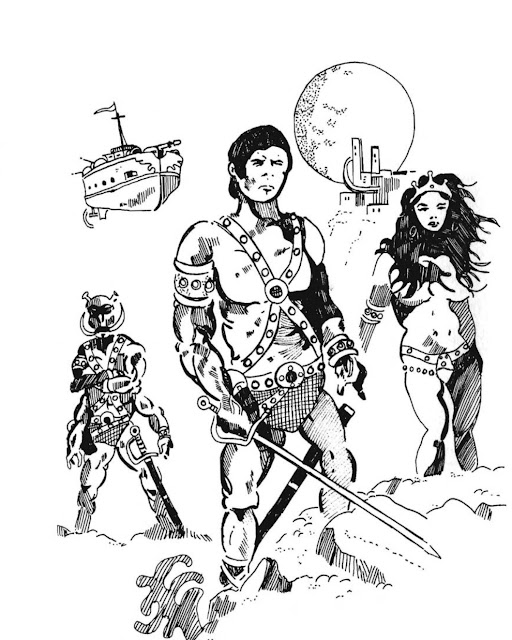Translating The Games Velocity, Turning, Hull Points and Megarons.
In the TSR Universe Star Probe came first then Star Empires which expands Star Probe and finally many years latter Star Frontiers Knight Hawk rules which clearly borrowed starship movement ideas from the two earlier games.
Velocity
Star Probe uses the term Acceleration Factor, Star Empires uses the term Acceleration and Star Frontiers uses the term Acceleration/Deceleration Factor abbreviated to ADF. In all three games the terms mean exactly the same. These terms all refer to the velocity per turn that the ship can accelerate or decelerate going in a straight line. Thus in all three games a ship with an ADF, A or AF of 3 can either increase its speed or decrease its speed by three hexes. I use the term ADF in all these games as it accurately describes what the number is.
Star Frontiers rules explicitly states there is no top speed. Star Empires velocity turning chart implies there is no top speed and Star Probe says nothing but does top out its velocity turning chart. Based on the chart in Star Empires I am pretty sure there was never a top speed in all three of these game rule sets. Thus a ship with an ADF of 3 can accelerate an additional 3 hexes every turn, so in three turns a ship would be traveling at a velocity of 9 in a straight line conversely it will take three turns to bring the ship to 0 a stop as it can only decelerate 3 each turn. A ship must always move in the direction its bow is facing.
Turning
Star Probe and Star Empires use a chart that determines how many hexes the ship must go based on its velocity at the start of the turn before it can make a turn. Star Probe uses square hexes so the ships turn 45 degrees, however Star Empires introduces the six sided hex for the battle board and the ship turns go up to 60 degrees. These charts are slightly different between the games. Another point of interest is every turn decelerates the ship by one, which means players must use ADF to compensate for the speed decreasing each turn completed to maintain speed the speed they wish to travel at. There is no cap on the number of turns a ship can make other than it must move x before making a turn.
Star Frontiers continues to use the six sided hex battle board inherited from Star Empires. Star Frontiers does not use a velocity based chart to determine maneuverability but instead uses a Maneuver Rating abbreviated as MR. In Star Frontiers this means the ship moves one hex and can immediately turn 60 degrees. Now this means if the MR is 4 the ship regardless of speed after it enters a new hex can turn once always facing one side of a hex, then move into the next hex and turn again. A ship can not turn more than its velocity will allow, with one exception. The MR fixes a problem in Star Probe/Empires turning in that every ship regardless of size or purpose turns the same, it simply does not work to have fighters as lumbering as a destroyer simply because of velocity. Ships in Star Frontiers do not loose velocity from turning.
Star Frontiers rules explain the exception. A ship that has a speed of zero through the entire turn can rotate during its movement phase so it faces any hex side.
Hull Points vs Megarons
The next major ship statistic you need in a space game is how much damage can your ship take before being destroyed. Star Frontiers uses Hull Points to determine how tough a ship is, while Star Probe/Empires uses the monetary value (in Megarons) of the damage to determine how much the ship can take. At first glance these look like very different numbers because of how they are explained in game terms, but when I was looking at the ships, space stations and so on I came to the conclusion mostly they require little to no change between games. I would transition all ships to Hull Points (HP) while retaining the Megaron costs.
Making It All Work
To make all three compatible as far as ship movement is concerned simply stop using the velocity turn charts and assign MR to all Star Probe and Star Empire ships. Or you could not use MR and turn all Star Frontier ships using the velocity/ turn charts. I personally prefer the MR being assigned by looking at similar Star Frontier ships. The charts make speed potentially even more dangerous as a ship must travel x number of hexes before it can make a turn regardless of MR. I might use the charts exclusively for ships above a certain hull size.
Jump Distance (JD) is used in Star Probe/Empires to determine how far a ship can jump in increments of 5 light years. All Star Frontiers maximum safe jump distance is 15 light years so their JD is automatically 3.
So far the ship stats for all three games should include ADF, MR, HP, and JD.
Bonus Rule For Hexes
The bonus conversion rule from Star Probe is if you only have big square hexes just use 45 degree turns instead. Yes it will effect the game in that to turn a ship from facing galactic north to galactic south it will take 4 turns using 45 degrees on a square hex versus 3 turns using 60 degree turns on a six sided hex. Currently large 6 sided hexes are available and I will get into hexes and battles more in a future article, but if you only have square grids you now have an option.
Next weapons and defenses.







Comments
Post a Comment